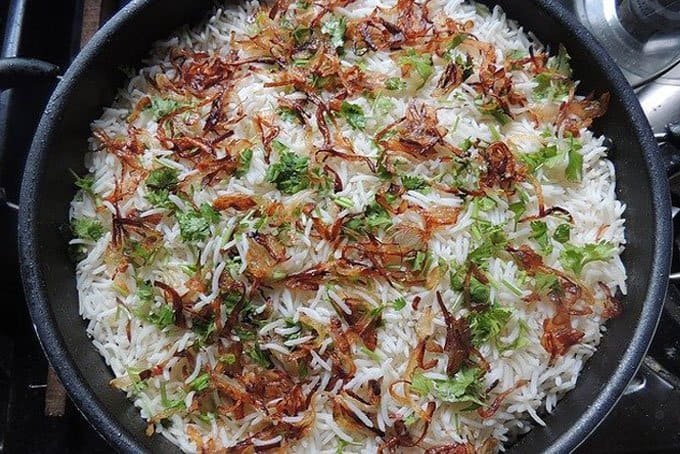Last Updated on January 6, 2021 by Dr Sharon Baisil MD
For years, the consumption of rice during diabetes has been a topic of hot debate in the medical field. This is also the area of intensive research.
Persistent efforts are being made to find out healthier variants of white rice that have a low glycemic index.
The commonly eaten white rice ranks high on the glycemic index chart and therefore is bad for diabetes.
Amidst these ongoing researches, two promising varieties with low glycemic index are discovered, namely basmati rice and red rice.
Both of them have a tough fight. After having an insightful analysis of the glycemic index of basmati and red rice, we can decide how beneficial can these varieties prove for diabetes.
What is the Glycemic Index of Basmati Rice?

To give you instant synopsis, the Glycemic Index of Basmati rice is estimated to be 50
Basmati rice is one of the good siblings of white rice blessed with the goodness of nature. If you have an active social presence, you must have come across Instagram posts or Facebook ads saying that basmati rice is better.
If we elaborate on this ‘better’ term, we have a lot of attributes to address.
Many people have shifted from white rice to basmati rice. And it has transformed their life. But what makes Basmati Rice so good is still a mystery for many people.
When you talk about rice, what is the first thing that comes to your mind? It has a high concentration of carbohydrates.
And when you think of basmati rice, the first thing that strikes your mind is its alluring aroma, undoubtedly.
It is because of this rich aroma that basmati rice is most widely used for making a famous Indian dessert called kheer.
That is right! White rice is full of complex carbohydrates that are broken down in your stomach and intestines.
Since it is rich in carbohydrates, it releases a large amount of energy. And in many ways, it contributes to obesity, which is not considered a healthy habit.
You might argue that there are people who consume white rice daily and have no connection to obesity or any other medical issue.
That is because they burn up all the energy that is released from white rice digestion. Their lifestyle is the reason for their fitness.
Today’s youth is aware enough regarding the significance of being fit and healthy. They take time off from their busy schedules to restrain stress and maintain good physical as well as mental health.
Gym memberships are on fire. Morning workouts are becoming a trend. Some people even their own private home gym with all the necessary equipment.
But if you have a sedentary lifestyle, probably spending hours in front of a laptop or sitting on a chair, you don’t perform enough movements to burn calories.
Then, it is best to opt for basmati rice. The best thing about basmati rice is that it has a low glycemic index of around 50.
It means that there is no sudden release of energy when basmati rice is digested. There is a slow release of carbohydrates, which ensures that your blood sugar level does not shoot up.
Basmati rice is typically long, soft, and fluffy when cooked. Each grain is separate, which can be easily enjoyed.
Another quintessence of basmati rice is that diabetes patients can enjoy it. People with diabetes are not allowed to consume white rice because of its high glycemic index.
But since basmati rice has a low glycemic index, it is a healthier option for diabetics.
Basmati rice is excellent for your heart. It has lower concentrations of saturated fats, which has a protective effect on your heart.
It should also be noted that basmati rice has more fiber than white rice. It helps maintain proper digestion.
If you are trying to lose weight, it is best to incorporate basmati rice into your diet. It is because of the low glycemic index and high fiber present in basmati rice. So, less energy is released with more amount of fibers.
What is the Glycemic Index of Red Rice?

With a glycemic index score around 55, red rice is another best food for diabetes
Red rice is somewhat like basmati rice. It too has a low glycemic index and is considered a better health alternative.
White rice is formed by polishing the original rice grains. It undergoes rigorous processing, which breaks down the outer shell and rips white rice of its nutritional coat.
On the other hand, red rice undergoes only partial polishing, which means the nutritional value of red rice is intact. It is rich in vitamins and minerals, which makes it a healthy addition to your meals.
In comparison to white rice, red rice is a whole grain food. It has everything that you will ever need. Red rice is standard in Africa, Thailand, and Bhutan.
Red rice has a glycemic index of around 55, which makes it a better option for diabetes. Rice is a staple food in India. We are accustomed to it.
And since diabetes is worsened by white rice, it is a big NO! Giving up rice is not as easy as it sounds; that is why it is best to replace white rice with red rice.
Besides diabetes, there are many other advantages to consuming red rice. Red rice is full of nutrients that help you carry out a healthy existence.
Compared to white rice red rice also has a lot of fibers and less amount of carbohydrates. It enables you to maintain weight and prevents indigestion episodes.
Moreover, the iron present in red rice is good for anemics and helps build bone strength.
Just like basmati rice, Red rice also protects you against heart and other cardiovascular diseases. It is because they have less amount of carbohydrates.
Furthermore, they have a good concentration of unsaturated fatty acids. It reduces the chances of plaque formation or heart attack.
But it should be noted that Red rice has a typical taste, which might not be acceptable to many. But this would be a small sacrifice to make for a healthy living.
And we honestly believe, this sacrifice is worthy of the benefits which red rice offers.
Basmati Rice vs. Red Rice – Which Is Better for Diabetes?
There is no doubt that both basmati rice and red rice are a better alternative than white rice. Their glycemic index is much lower than white rice.
They have lesser carbs and more fiber and nutrients. No wonder they are so good for your body.
But the real question is which one is better from the diabetes point of view – basmati rice or red rice?
If you look closely, you will realize that even though basmati rice and red rice have a similar nutritional profile, the glycemic index of basmati rice is lower.
Which automatically means controlled release of digested carbohydrates. There is no sudden rise in blood sugar after meals, and you don’t need to depend on insulin shots.
Moreover, it helps maintain a good feeding pattern. It keeps you full for longer and enables you to get over unhealthy eating habits.
Red rice does the same. But there is a significant difference when it comes to taste, texture, appearance, and nutrients.
Red rice is essentially a wild variety and has more nutrients than basmati rice. But because of the comparatively higher glycemic index, one should not choose red rice over basmati rice.
Furthermore, flavor-wise red rice is not the first choice of many. It has a more or less coarse and nutty flavor. And it is a big change to shift from white rice to red rice.
On the other hand, Basmati rice has a similar disposition as white rice. So, it is smart if you opt for red rice to control your diabetes.
When it comes to diabetes, the only thing that matters is the glycemic index. You can gather nutrients from other sources, but rice is the single major source of carbohydrates.
Although essential, carbohydrates can cause a lot of problems in people with diabetes. So better stick with the variety, which has a lower glycemic index.
Moreover, basmati rice is a more economical choice in comparison to red rice. Low glycemic index and low prices make basmati the ideal rice for people with diabetes.
Glycemic Index and Diabetes – What’s the Connection?
The food we eat contains carbohydrates. These carbohydrates are broken down into simple sugars during the digestion process.
The Glycemic index score of food tells you how fast or how slow will the food converts its carbohydrates into sugars.
If this conversion proceeds at a faster rate, then there are high chances that your blood sugar levels will go up.
But if the conversion of carbohydrates to sugar occurs at a moderate pace, your blood sugar levels are rendered stable.
Usually, the more is the number of carbohydrates, the more will be the glycemic index value for any food.
Here on, the glycemic index value of food finds great importance in formulating the right kind of diabetic diet.
Since carbohydrates are the main source of energy for our body and rice caters to about 70% of our body’s energy needs. It is not a wise decision to eliminate rice as such from our daily diet.
Instead, finding nutritious rice varieties that favors diabetes with low glycemic index value will be a smarter option.
Concluding words
Rice has been an integral part of Indian meals. From regular dishes to festive delicacies to religious eatables, we employ rice in a number of things we cook.
It is not an easy deal for people to wipe off rice from their plates. But we can’t keep up a healthy lifestyle with the continuous use of white rice. At least, not in the case of diabetes and obesity.
So, what’s the solution? The only practical solution that emerges is the adoption of healthier rice varieties.
This comparison of brown rice and red rice was to present to you the plethora of benefits they serve. This discovery is a boon for diabetics all over the world.
The bottom line corresponds to the glycemic index of brown and red rice. Brown rice is low in glycemic index value wins the title for being the better choice between the two.
References
- https://pubmed.ncbi.nlm.nih.gov/31619639/
- https://pubmed.ncbi.nlm.nih.gov/19169946/
- https://pubmed.ncbi.nlm.nih.gov/24447043/
- https://pubmed.ncbi.nlm.nih.gov/26352188/
- https://pubmed.ncbi.nlm.nih.gov/27213446/
- https://pubmed.ncbi.nlm.nih.gov/27253526/
- https://pubmed.ncbi.nlm.nih.gov/29978570/
- https://pubmed.ncbi.nlm.nih.gov/31006420/
- https://pubmed.ncbi.nlm.nih.gov/27295427/
- https://pubmed.ncbi.nlm.nih.gov/31619639/
- https://pubmed.ncbi.nlm.nih.gov/31619642/






Which is best Red,Brown or basmati Rice and not fattening??
Red rice is the best choice, out of the 3, due to its rich fiber content